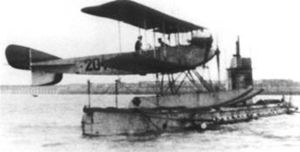SM U-12 was a German submarine, built in 1911 and sunk off Scotland in 1915. It was the first submarine to launch a plane at sea. U-12 was a Type U 9 U-boat built for the Imperial German Navy. Her construction was ordered on 15 July 1908 and her keel was laid down by Kaiserliche Werft in Danzig. She was launched on 6 May 1910 and commissioned on 13 August 1911.
 SM U-12 with seaplane on deck
| |
| History | |
|---|---|
| Name | U-12 |
| Ordered | 15 July 1908 |
| Builder | Kaiserliche Werft Danzig |
| Cost | 2,140,000 Goldmark |
| Yard number | 7 |
| Launched | 6 May 1910 |
| Commissioned | 13 August 1911 |
| Fate | Sunk 10 March 1915 off Eyemouth, Scotland |
| General characteristics [1] | |
| Class and type | German Type U 9 submarine |
| Displacement | |
| Length | 57.38 m (188 ft 3 in) |
| Beam | 6 m (19 ft 8 in) |
| Draught | 3.13 m (10 ft 3 in) |
| Installed power | |
| Propulsion | 2 shafts |
| Speed |
|
| Range | 1,800 nmi (3,300 km; 2,100 mi) at 14 knots (26 km/h; 16 mph) |
| Test depth | 50 m (160 ft) |
| Boats & landing craft carried | 1 dingi |
| Complement | 4 officers, 25 men |
| Armament |
|
| Service record | |
| Part of: |
|
| Commanders: |
|
| Operations: | 4 patrols |
| Victories: |
|

The German Empire was the first nation to experiment with submarine aircraft carriers. Oberleutnant zur See Friedrich von Arnauld de la Perière of the Naval Air Service and U-12's Kapitanleutnant Walther Forstmann theorised that they could increase the range of their seaplanes by carrying the aircraft out to sea on the deck of submarine and launching the seaplanes after the sub partially submerged, allowing the plane to float off.
Service history
editOn 6 January 1915 U-12 left Zeebrugge transporting a Friedrichshafen FF.29 seaplane on its deck. Once beyond the safety of the breakwater, the captain realised that the heavy swell might swamp the aircraft and ordered the immediate launch of the seaplane. Forstmann flooded the sub's forward tanks and Arnauld floated the seaplane off the deck and took off from the sea. The German plane flew along the English coastline undetected and returned safely to Zeebrugge.[4]
U-12 torpedoed the British gunboat HMS Niger at Deal on 11 November 1914.[5][6] This was the first Allied casualty from submarines based in Belgian ports.[7]
On 10 March 1915, while on patrol off the east coast of Britain, U-12 was hunted down by the three Royal Navy destroyers HMS Ariel, HMS Acheron and HMS Attack.
Fate
editThe submarine attempted to dive under the surface but was rammed by Ariel. U-12 then surfaced and was shelled by Acheron and Attack and sank with the loss of 19 lives although 10 survivors were rescued.
Wrecksite
editIn January 2008, divers Jim MacLeod, of Bo'ness, and Martin Sinclair, from Falkirk, found the wreckage of U-12 about 25 miles from Eyemouth after a five-year search.[8][9]
Summary of raiding history
edit| Date | Ship Name | Nationality | Tonnage[Note 1] | Fate[10] |
|---|---|---|---|---|
| 11 November 1914 | HMS Niger | Royal Navy | 810 | Sunk |
| 9 March 1915 | Aberdon | United Kingdom | 1,005 | Sunk |
Notes
edit- ^ Merchant ship tonnages are in gross register tons. Military vessels are listed by tons displacement.
References
edit- ^ Gröner 1991, pp. 4–6.
- ^ Helgason, Guðmundur. "WWI U-boat commanders: Walter Forstmann (Pour le Mérite)". German and Austrian U-boats of World War I - Kaiserliche Marine - Uboat.net. Retrieved 30 April 2016.
- ^ Helgason, Guðmundur. "WWI U-boat commanders: Hans Kratzsch". German and Austrian U-boats of World War I - Kaiserliche Marine - Uboat.net. Retrieved 30 April 2016.
- ^ Layman, R. D. (April 1968). "U-boats with Wings". U.S. Naval Institute Proceedings. 94 (4): 54–59.
- ^ wrecksite.eu (2014). "HMS Niger [+1914]". wrecksite.eu. Retrieved 11 November 2014.
- ^ Helgason, Guðmundur. "Ships hit during WWI: HMS Niger". German and Austrian U-boats of World War I - Kaiserliche Marine - Uboat.net. Retrieved 30 April 2016.
- ^ Helgason, Guðmundur. "WWI U-boats: U 12". German and Austrian U-boats of World War I - Kaiserliche Marine - Uboat.net. Retrieved 30 April 2016.
- ^ Fairborn, Robert (15 January 2008). "German U-boat sunk 90 years ago found after five-year search". The Herald. Archived from the original on 18 January 2008. Retrieved 17 January 2008.
- ^ "Divers discover U-boat wreckage". BBC News. 14 January 2008. Retrieved 17 January 2008.
- ^ Helgason, Guðmundur. "Ships hit by U 12". German and Austrian U-boats of World War I - Kaiserliche Marine - Uboat.net. Retrieved 30 April 2016.
Bibliography
edit- Gröner, Erich; Jung, Dieter; Maass, Martin (1991). U-boats and Mine Warfare Vessels. German Warships 1815–1945. Vol. 2. Translated by Thomas, Keith; Magowan, Rachel. London: Conway Maritime Press. ISBN 0-85177-593-4.
- Rössler, Eberhard (1985). Die deutschen U-Boote und ihre Werften: U-Bootbau bis Ende des 1. Weltkriegs, Konstruktionen für das Ausland und die Jahre 1935–1945 [The German Submarines and Their Shipyards: Submarine Construction Until the End of the First World War] (in German). Vol. I. Koblenz: Bernard & Graefe. ISBN 3-7637-5213-7.
External links
edit- Helgason, Guðmundur. "WWI U-boats: U 12". German and Austrian U-boats of World War I - Kaiserliche Marine - Uboat.net. Retrieved 30 April 2016.